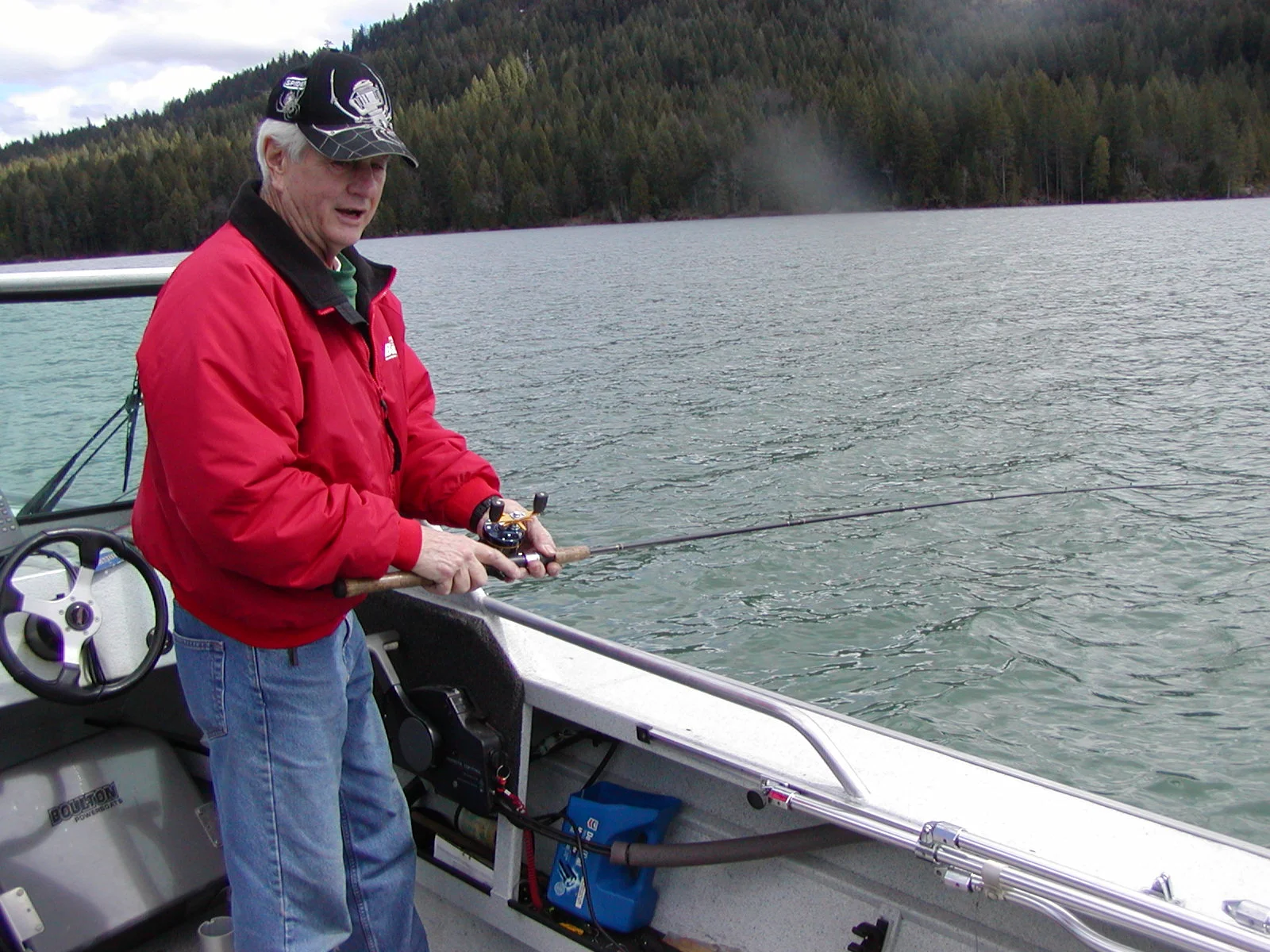Denis Peirce
[This column first appeared in "The Union" Newspaper, Grass Valley CA March 22, 2012.]
The Holy Grail for trout anglers is a trophy brown trout. Rainbows can grow big in you-catch-em ponds but trophy-sized browns are solitary predators that inhabit big water.
In California, a six-pounder is rare enough to be considered a wall hanger. In the Great Lakes, a brown needs to be at least in the high teens to get noticed.
In Utah’s Flaming Gorge Reservoir, a 20-pounder gets you into trophy range.
There is a local angler who has achieved all of these marks. Jim Bringhurst has been pursuing his brown trout passion since the 1960s.
Jim Bringhurst at his preferred fishing position on his boat. The lake surface "ripple" is perfect for fish to be shallow.
His career as a fireman in Southern California afforded him the long weekends to spend fishing. He and his wife Kathy moved to Grass Valley in 1999.
Bringhurst was one of the less than a dozen anglers who formed the legendary “Brown Baggers Club” in the early 1970s. To become a member of the club you must catch at least two browns over 10 pounds.
One brown over 10 pounds could be luck. A second brown over that mark demonstrates a level of skill.
Since moving to our area, Bringhurst has been fishing a number of area waters. Little Grass Valley, Donner, Stampede and Tahoe have seen a number of trips by Bringhurst and his boat.
On his more distant sojourns, Bringhurst travels to Twin Lakes near Bridgeport, and a number of lakes in the Bend, Ore., area.
In November of 2010, he even pulled his boat to Wisconsin to fish Lake Michigan for 10 days.
His largest brown was a 26-pound behemoth caught at Flaming Gorge Utah in 1977. He was in the boat when his brother Bob – another founding member of the “Brown Baggers” – landed a 33-pounder from Flaming Gorge, also in 1977.
Bob’s fish remains the lake record and for a time held the world record.
This week I had the opportunity to fish Scott’s Flat with Bringhurst. It was an opportunity to learn from a master the way to catch browns. We chose Wednesday because of the forecast of cloudy skies with a moderate breeze.
The mechanics of Bringhurst’s technique are not that complicated. He fishes nonstretching braided line, 15- to 20-pound break strength http://www.trollingflies.com/accessories-2/ , followed by 50 feet of 8- to 12-pound fluorocarbon leader. The lure that he prefers is a No. 13 floating Rapala in a rainbow trout color scheme.
For many years prior to Rapala introducing a factory rainbow paint job, Bringhurst would wash the black over white finish off the plugs with acetone and repaint them himself. He continues to prefer his own painted versions.
Jim's custom painted plug.
The way in which he fished these plugs is unusual. He does not put the rod in a holder and troll at a steady speed. Bringhurst cruises the perimeter of the lake staying in water from 10 to 30 feet deep.
He varies his speed from 2.5 up to 3.3 mph and follows the contour of the lake shore. He removes the driver’s seat and stands at the helm with his rod in his hand.
For our entire five hours on the water, Bringhurst kept sweeping the rod forward over the water and then letting it drift to the rear followed by another sweep of the rod.
He explained to me that the fast boat speed combined with the rod sweep gave a frantic wobble to the plug followed by a pause. The No. 13 floating plug runs 5 to 7 feet deep when fished this way.
It is Bringhurst’s belief that browns don’t contemplate a strike, rather they just react to a fast moving meal that is about to escape. Based on years of comparing a rod in a holder versus the sweeping of an angler held rod, the results favor Bringhurst’s method 5:1.
Of all of components of Bringhurst’s brown trout hunting methods, such as rods and reels, lures, boat speed and time of the year, the number one factor that has been the key to his success is his persistence.
In his prime Bringhurst, would be on the water sunrise to sunset, day after day. In retirement, he is now open to taking a break midday but being back on the water into the low light hours of the evening.
A trophy brown is primarily a nocturnal creature in the good weather months. Bringhurst targets the colder periods of spring and fall. Year after year, his most productive time frame is the first couple weeks of November.
That is when he traveled to Lake Michigan in 2010 and it is the time you might see him on Little Grass Valley Reservoir or Donner Lake, weather permitting.
Among his notable Northern California catches since moving to western Nevada County have been an 11-pounder from Donner Lake, a 9.75-pounder from Little Grass Valley and an 18.7-pounder from Lower Twin Lake near Bridgeport.
During our afternoon on Scott’s Flat Lake, we did quite well catch-and-releasing a respectable number of stocker rainbow trout. Even a 12-inch rainbow will respond to Bringhursts’ presentation. As you would expect I fished my flies. Scott's Flat Lake has the pond smelt as the primary bait fish so I fished my white tube fly and learned that even at these high speeds rainbows will chase flies down and bite them.
But as is often the case, the trophy brown eluded us. The only answer to this is a return trip to the lake. We just did not put in enough hours on the water to earn a big brown.
Denis Peirce writes a weekly fishing column for The Union and is host of “The KNCO Fishing & Outdoor Report,” which airs 6 to 7 p.m. Fridays and 5 to 6 a.m. Saturdays on 830-AM radio. Contact him via email at dpeirce@theunion.com or visit his website at trollingflies.com.



